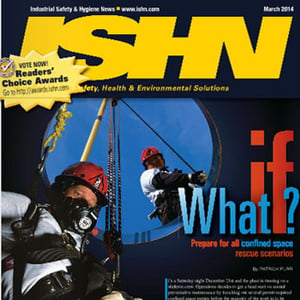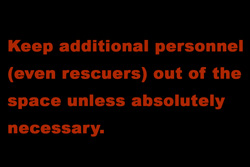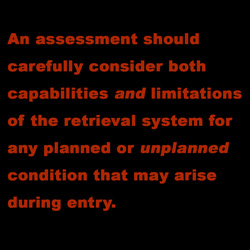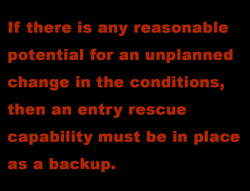
Crank It Up a Notch with Roco’s CASEVAC II Training
It has been an honor for us to expand our support of our nation’s heroes to the greater SOCOM community. When we developed the TCCC CASEVAC Extraction kits and subsequent training, our goal was to assist operators around the world in saving the lives of their buddies in need. While SOCOM did a commendable job in bridging a broad capabilities gap with the CASEVAC Set, a training gap still exists for more advanced extraction training.
Roco trained over 700 operators within all four branches of our military during the time we offered NET courses at the Roco Training Center. Now that this training and equipment has been used in the field for a few years, we would like to propose the following questions:
- When was the last time you practiced the skills learned in the NET course?
- Or, broke out the Micro RIES® and built a haul system?
- Or, the last time you lifted a vehicle or debris using the lift bags?
- What about the skills that the NET course didn’t cover?
Now is the time to take it to the next level with Roco’s CASEVAC Extraction Level II. This course builds upon the foundation of the skills offered in the NET course and gives operators a few more ways to get the job done.
 The beauty of these “rescue” skills is that most of them can be applied to everyday missions outside of the context of rescue. If you can haul Mongo onto a roof while he’s packaged in a Sked litter, then you can definitely haul up some equipment. If you can rappel into a well to save a fallen teammate and ascend back out, then you can access and bail out of OPs more quickly, safely, and efficiently. Lifting and extrication tools and techniques can be applied to SSE as well as rescue.
The beauty of these “rescue” skills is that most of them can be applied to everyday missions outside of the context of rescue. If you can haul Mongo onto a roof while he’s packaged in a Sked litter, then you can definitely haul up some equipment. If you can rappel into a well to save a fallen teammate and ascend back out, then you can access and bail out of OPs more quickly, safely, and efficiently. Lifting and extrication tools and techniques can be applied to SSE as well as rescue.We’d like to invite you to help drive the curriculum of this course. Roco will be holding two (2) pilot courses in order to validate the curriculum we’ve developed. A detailed description is located at our Tactical Courses page. Your feedback will help determine which skills are vital to include.
Not currently under SOCOM’s umbrella? No worries. While this course was designed with the CASEVAC Set of equipment in mind, the principles apply universally.Since equipment changes, we focus on the principles. In this course, we start from the ground up, refreshing things covered in NET, and using equipment from the CASEVAC Set as well as gear that is used by other SOF units around the world. By using several variations of equipment, you’ll gain higher proficiency and be able to use your team’s equipment more effectively, whether it’s the CASEVAC Set or not.

 The following article was featured on the cover of the March 2014 issue of ISHN, and authored by Roco's own Chief Instructor Pat Furr.
The following article was featured on the cover of the March 2014 issue of ISHN, and authored by Roco's own Chief Instructor Pat Furr.


 Well, maybe not half the time, but certainly some fraction of the time.
Well, maybe not half the time, but certainly some fraction of the time. Two key points that must be considered: (1) OSHA follows the ANSI approach that was in effect at the time 1910.146 was promulgated which did not recommend a minimum mechanical advantage ratio; and, (2) The rule makers intended to leave a degree of latitude for the rescue service to select a lifting device that is most appropriate for the particular situation encountered.
Two key points that must be considered: (1) OSHA follows the ANSI approach that was in effect at the time 1910.146 was promulgated which did not recommend a minimum mechanical advantage ratio; and, (2) The rule makers intended to leave a degree of latitude for the rescue service to select a lifting device that is most appropriate for the particular situation encountered. As anyone who has ever been summoned to an industrial site for a confined space rescue, or has taken the opportunity to practice rescue drills in these facilities knows, sometimes the working area for the rescue team can be a tad cozy. By “cozy” we mean cramped. If there is the need for a haul of the rescuers or victim after a lower, these cramped conditions can cause multiple problems. Consider it a challenge to overcome, and use your rope rescue know-how to come up with an efficient solution that will not only reduce congestion at the working area, but will most likely provide for a much faster haul of the rescue package.
As anyone who has ever been summoned to an industrial site for a confined space rescue, or has taken the opportunity to practice rescue drills in these facilities knows, sometimes the working area for the rescue team can be a tad cozy. By “cozy” we mean cramped. If there is the need for a haul of the rescuers or victim after a lower, these cramped conditions can cause multiple problems. Consider it a challenge to overcome, and use your rope rescue know-how to come up with an efficient solution that will not only reduce congestion at the working area, but will most likely provide for a much faster haul of the rescue package. If the opportunity presents itself, take advantage of a simple change of direction on the haul system. At times, a single 90-degree change of direction can convert a short 3-4 foot throw into a throw many times longer. We see this all the time on catwalks, yet it is often overlooked by our rescue teams when we throw scenario-based training evolutions at them. Yes, it does require some extra equipment which typically amounts to a single sheave pulley, a carabiner, and a utility strap. It also adds some frictional losses at that directional pulley, but the advantage gained by extending the throw from 3-4 feet to 20 or more feet, far outweighs the disadvantages of extra equipment, added friction, and time needed to make the change.
If the opportunity presents itself, take advantage of a simple change of direction on the haul system. At times, a single 90-degree change of direction can convert a short 3-4 foot throw into a throw many times longer. We see this all the time on catwalks, yet it is often overlooked by our rescue teams when we throw scenario-based training evolutions at them. Yes, it does require some extra equipment which typically amounts to a single sheave pulley, a carabiner, and a utility strap. It also adds some frictional losses at that directional pulley, but the advantage gained by extending the throw from 3-4 feet to 20 or more feet, far outweighs the disadvantages of extra equipment, added friction, and time needed to make the change.



